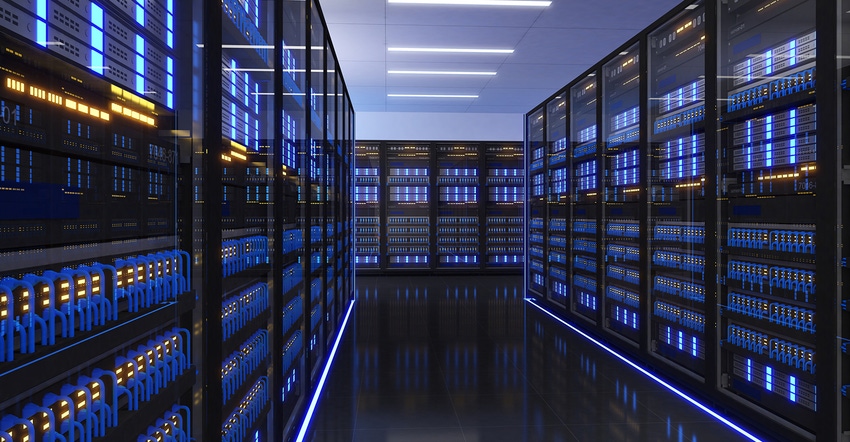
Datacenter downtime due to power outages can cause substantial financial and brand damage to any business. Traditionally a backup power system for datacenters includes backup generators and uninterruptable power supply (UPS) units with N+1 redundancy levels or greater. Often, UPS systems are built using lead-acid batteries but the adoption of other battery chemistries for datacenter is growing steadily.
Lithium-ion batteries for datacenters
Most datacenters use a valve-regulated lead-acid (VRLA) cell battery to power UPS systems. But the datacenter industry has started to adopt new battery technologies in a quest to lower costs and build more efficient datacenters with smaller carbon footprints.
One of the lithium-ion batteries that is progressively being adopted for datacenters backup power applications is the lithium iron phosphate (LFP) battery. This type of lithium-ion battery uses LFP as the cathode material, and a graphitic carbon electrode with a metallic backing as the anode. LFP batteries are becoming a popular choice for datacenter backup power because of their high energy density, which means they can store large amount of energy in a relatively small footprint—particularly important for datacenters where space is always a premium asset.
LFP batteries offer long cycle life, therefore they can manage many charge and discharge cycles without significant degradation. In other words, they can have longer lifespan than other lithium-ion chemistries, and they also require little maintenance. LFP batteries offer a high safety record due to their stable chemistry and they also show great resistance to thermal runaway (518ºF). They can operate over a wide temperature range, which make them suitable for operating in environments that experience extreme temperatures, reducing the need for cooling in datacenters while fulfilling sustainability goals while lowering costs.
There are several companies that are already offering LFP batteries for UPS systems in datacenters. Here are a few examples:
1.MPINarada offers a high-power, uninterrupted power supply (UPS) lithium battery system for high-rate applications that provides an energy-dense lithium iron phosphate (LFP) solution. The MPLhP systems can operate in temperature ranges up to 35ºC, while meeting all certifications, including, UL 1964, UL 1973, UL 9540A testing, and IEC 62619.
2.SAFT Batteries offers a Super Lithium Iron Phosphate (SLFP) proprietary technology, Flex'ion, which is a lithium-ion UPS battery solution for datacenters. Their product is highly sustainable, and it operates at high temperatures (35ºC), enabling significant electricity and water savings.
The potential of sodium-ion batteries
Rechargeable sodium-ion batteries (SIB) are finding their space in mission-critical applications such as datacenters. They have similar working principle to the lithium-ion batteries, but they can charge and discharge faster than the latter. Unlike lithium-ion batteries, SIBs can be stored or transported at an empty energy state (0V). They also have great potential because, as sodium is the sixth most abundant material on Earth, it should be easier and cheaper to secure a supply chain for them. And SIB batteries offer no risk of thermal runway—unlike some lithium-batteries that are more predisposed to catch fire.
Various companies are already product planning or manufacturing sodium-ion batteries for EV and personal electronic applications (e.g., CATL). But Natron Energy is one of the few companies that is offering SIB backup-power products for datacenters: Their product in this space is called the Blue Rack battery cabinet. According to Natron, its sodium-ion technology can produce far greater maximum sustained power per energy (40W/Wh) compared to lithium-ion (10W) and lead acid (7W), and its cycle life is five times greater than lithium-ion and fifty times greater than lead acid.
“This is the longest-lasting, highest-power, and above all safest battery available for these applications,” stated Robert Rogan, Chief Business Officer at Natron. “The sodium-ion technology in the Blue Rack outperforms lithium-ion and lead acid in every critical metric – especially safety.”
As the demand for renewable energy sources and energy efficiency continues to grow, viable VRLA battery alternatives will likely play an increasingly role in the datacenter industry. Data center technology will continue to grow and evolve aiming to provide a service that is not only reliable and cost effective but sustainable and green.
“The global battery manufacturing capacity is growing, but more effort is needed to satisfy the increasingly high demand for EVs and cleaner technologies. These are the same battery technologies used for UPS and battery energy storage systems (ESS), so it is no coincidence that the data center industry will continue to benefit from all the research in the EV industry,” said Moises Levy, PhD, Senior Principal Analyst at Omdia, leading the data center power and cooling research, part of the Cloud and Data Center research practice.
“We expect the UPS battery market to grow at 9.8% CAGR 2021–30, reaching $4B by 2030. Lithium-based battery adoption for UPS in data centers is expected to continue its fast growth, displacing the long-time established lead-acid batteries. Lithium-based batteries are expected to dominate the UPS battery market, reaching 65% of the global revenue by 2030,” Dr Levy noted “Despite the hype around new battery chemistries (e.g., sodium-ion, nickel-zinc and liquid metal), we expect them to make up about 10% of the UPS battery market opportunity by 2030.”
About the Author(s)
You May Also Like





